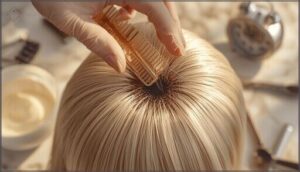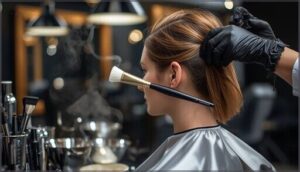This site is supported by our readers. We may earn a commission, at no cost to you, if you purchase through links.
Your hair can only take so much punishment before it starts waving a white flag—and bleach is one of the most demanding treatments you can throw at it. The cuticle layer that protects each strand gets lifted and stripped during lightening, which means timing your sessions isn’t just about maintaining that perfect platinum. It’s about keeping your hair attached to your head.
Most hair can handle a full bleach every four to six weeks, but that number shifts dramatically based on your starting point, the developer strength you’re using, and how much damage already exists. Push too hard, too fast, and you’ll trade length for breakage. Understanding your hair’s limits gives you the freedom to go lighter without the fallout.
Table Of Contents
- Key Takeaways
- How Often Can You Bleach Your Hair?
- What Happens if You Bleach Hair Too Often?
- How Long Should You Wait Between Bleaching Sessions?
- Can You Bleach Hair Twice in One Day?
- How Does Bleaching Affect Hair Structure?
- What Are The Signs of Bleach-Damaged Hair?
- How to Assess if Your Hair is Ready for Bleaching Again
- How to Care for Hair After Bleaching
- How Often Can You Bleach Roots Safely?
- Should You Seek Professional Help for Bleaching?
- Frequently Asked Questions (FAQs)
- Conclusion
Key Takeaways
- Wait 4–6 weeks between full bleaching sessions, but stretch that to 8–10 weeks if your hair’s already showing signs of damage like dryness or breakage.
- Bleaching twice in one day is a gamble you’ll lose—it causes irreversible structural damage that no treatment can fully repair.
- Run a strand test and check your hair’s elasticity before each session; healthy hair stretches about 50% when wet and bounces back without snapping.
- Post-bleach recovery isn’t optional—alternate protein treatments every 4–6 weeks with deep conditioning to rebuild what the lightener stripped away.
How Often Can You Bleach Your Hair?
You can’t just bleach your hair whenever the mood strikes—there are real limits that keep your hair from turning into straw. The timing between sessions depends on what you’re doing to your hair and what condition it’s already in.
Let’s break down the waiting periods and what actually affects how often you can safely lighten your hair.
Recommended Waiting Periods
Generally, you’ll want to wait 4–6 weeks between full bleaching sessions—this hair bleaching frequency gives your cuticle time for bleach recovery and reduces damage prevention needs. Root touch-ups follow similar bleaching intervals, aligning with hair regrowth cycles.
If your hair’s already compromised, push that timeline to 8–10 weeks for proper hair restoration before risking another round. Understanding the hair bleaching process is essential for maintaining healthy hair.
Factors Affecting Bleaching Frequency
Your hair’s bleaching frequency factors depend on more than just time—hair porosity from chemical damage, your hair thickness, and scalp sensitivity all play key roles. Previously bleached strands can’t handle as much abuse; darker, coarser hair needs longer recovery between sessions.
Even bleach formulations matter: higher-volume developers lift faster but demand extended healing periods, affecting your entire bleaching timeline. It’s vital to keep in mind the risks of scalp bleach damage when determining how often to bleach your hair.
What Happens if You Bleach Hair Too Often?
Pushing your hair too far with back-to-back bleaching sessions can turn your strands from blonde bombshell to crispy disaster—and once you cross that line, there’s no quick fix.
Your hair will send you warning signals long before it breaks off completely, but ignoring them leads to damage that goes way beyond a bad hair day.
Let’s break down what actually happens when you bleach too often, starting with the red flags you need to watch for.
Signs of Over-Bleached Hair
Your hair will practically scream when you’ve crossed the line—watch for telltale Hair Damage Signs like straw-like dryness, brittleness, and that gummy texture when wet.
Overbleaching strips away your hair’s natural armor, cranking up Hair Porosity and triggering Hair Breakage that snaps with every brush stroke.
Frizz Control becomes impossible, split ends multiply, and that dull, lifeless look? That’s Bleach Damage telling you to pump the brakes.
Long-Term Consequences
Beyond the immediate chaos, cumulative damage from overbleaching wages war on your long-term hair health and future treatments:
- Protein loss reaches deep into the cortex, destroying up to 95% of your hair’s structural foundation
- Scalp health deteriorates, risking chemical burns and disrupting your growth cycle
- Hair thinning emerges as follicles weaken from repeated chemical assault
- Texture changes become permanent as moisture retention plummets
- Future treatments lose effectiveness on your compromised, porous strands
Hair damage prevention isn’t optional—it’s survival.
How Long Should You Wait Between Bleaching Sessions?
The waiting period between bleaching sessions isn’t one-size-fits-all—it depends on what you’re bleaching and how your hair’s holding up. Whether you’re going all-over platinum or just touching up your roots, the timeline shifts based on your specific situation.
Here’s what you need to know about spacing out your bleaching sessions safely.
Guidelines for All-Over Bleaching
When tackling an all-over bleach application, you’ll need to wait 4 to 8 weeks between sessions—longer if you’re chasing serious color correction. Hair porosity and bleach strength matter here; compromised hair health demands extended recovery time.
After significant bleach damage, your colorist might push that timeline to 8 weeks or more, giving your cuticle proper recovery and preventing the kind of breakage that ends hair bleaching techniques altogether.
Guidelines for Root Touch-Ups
Generally, you can safely schedule root touchups every 4 to 6 weeks—your hair regrowth determines the sweet spot. Overlapping bleach onto previously lightened sections causes breakage, while pushing beyond 6 weeks creates uneven color banding that’s harder to correct.
Here’s your safe touch-up frequency breakdown:
- Rapid growers or high contrast: Every 3-4 weeks for consistent results
- Standard timing: 4-6 weeks balances root bleach timing with scalp sensitivity
- Slower growth or balayage: Stretch to 8 weeks without compromising coverage
Recovery Period for Damaged Hair
When significant bleach damage sets in—think breakage, split ends, or complete elasticity loss—you’re looking at a four to twelve-month hair recovery timeline before you can safely bleach again.
Severe cases demand damage assessment by a professional, since hair restoration depends on your unique bleach reversal progress and new hair regrowth. Rushing this recovery timeframe guarantees more hair breakage, not transformation.
Can You Bleach Hair Twice in One Day?
You might be tempted to bleach your hair twice in one day to speed up the lightening process, but this approach carries serious risks that can permanently damage your hair. Even though it seems like a shortcut to getting that platinum blonde you’re after, your hair simply can’t handle that much chemical processing in such a short timeframe.
Let’s break down why double bleaching is a gamble you don’t want to take, and what safer options you have instead.
Risks of Double Bleaching
Bleaching twice in one day? That’s playing Russian roulette with your hair’s structural integrity. Double bleaching causes immediate cuticle damage and chemical overload, leading to severe hair fracture within hours.
Bleaching your hair twice in one day is playing Russian roulette with your strands, risking immediate cuticle damage and irreversible breakage within hours
The consequences of overbleaching compound rapidly—you’ll see extensive hair breakage, bleach toxicity to proteins, and structural degradation that’s fundamentally irreversible. Your hair literally can’t rebuild what’s been stripped away that aggressively.
Safe Alternatives to Rapid Lightening
Want lighter hair without the carnage? Natural lightening methods like lemon juice (showing one-shade shifts after 3-5 applications) or chamomile rinses give you sunless highlights over several weeks.
Hair masks with honey provide gentle bleach effects while moisturizing simultaneously.
Herbal dyes offer color shifts without demolishing your hair’s integrity—these alternatives to hair bleach let you experiment while preventing hair damage and safely bleaching hair twice becomes unnecessary.
How Does Bleaching Affect Hair Structure?
Bleaching isn’t just about changing color—it’s a chemical process that fundamentally alters your hair’s internal structure and protective layers. Understanding what’s happening beneath the surface helps you make smarter decisions about timing, frequency, and aftercare.
Here’s what bleach actually does to your hair from the inside out.
The Chemical Process Explained
Your hair’s transformation starts with a chemical rebellion—bleach formulas containing hydrogen peroxide and ammonia stage an assault on melanin molecules through oxidation.
Here’s what happens during chemical processing:
- Ammonia raises pH to 9-11, swelling the cuticle for deeper penetration
- Hydrogen peroxide oxidizes eumelanin first, then pheomelanin pigments
- Persulfate salts accelerate the melanin breakdown process
- Oxygen radicals fragment color molecules, neutralizing pigment
- Disulfide bonds weaken as chemical reactions reshape hair structure
Impact on Hair Cuticle and Proteins
The chain reaction doesn’t stop at color—bleach shreds your hair’s protective armor from the outside in. Within a single session, more than 80% of the fatty acid layer coating your cuticle vanishes, exposing raw protein underneath. Those overlapping scales lift, fragment, and peel away while oxidative stress converts stabilizing disulfide bonds to cysteic acid, triggering structural weakening that compromises tensile strength and increases hair porosity with every application.
| Damage Type | Visible Effects | Protein Impact |
|---|---|---|
| Cuticle Damage | Rough texture, tangling | 18-MEA lipid loss (80%+) |
| Oxidative Stress | Dullness, fragility | Disulfide bonds → cysteic acid |
| Protein Degradation | Breakage, splitting | Reduced tensile strength |
| Hair Porosity | Excessive moisture uptake | Cortex fissures, internal cracks |
| Structural Weakening | Loss of elasticity | Decreased thermal stability |
What Are The Signs of Bleach-Damaged Hair?
Your hair will tell you when bleach has pushed it too far, but you need to know what signs to look for. Catching damage early gives you the chance to repair and recover before things get worse.
Let’s break down the most common red flags that show up after bleaching.
Dryness, Brittleness, and Breakage
The most telling signs of over-processing often appear within days: your hair feels like straw, snaps when you brush it, and sheds strands constantly.
This happens because bleach causes protein degradation and cuticle damage, stripping up to 32% of moisture and weakening fiber structure by 35%.
Hair moisture loss leads to brittleness, while structural weakness triggers breakage and split ends you can’t ignore.
Dullness, Frizz, and Split Ends
Beyond brittleness and breakage, you’ll notice your hair loses its shine and becomes a frizzy, dull mess—up to 62% of people report this after multiple bleaching sessions.
Increased hair porosity from cuticle damage allows moisture to penetrate irregularly, causing frizz in over 60% of cases, while split ends appear in 71% of individuals after three or more treatments.
Dullness prevention and split end repair are essential priorities.
How to Assess if Your Hair is Ready for Bleaching Again
Before you reach for the bleach again, you need to know if your hair can actually handle it. Guessing won’t cut it—there are two reliable ways to check whether your strands are strong enough for another round.
Here’s how to test your hair’s readiness and avoid a bleaching disaster.
Conducting a Strand Test
Before you go full throttle with bleach, running a strand test is your insurance policy against disaster. This simple safety protocol reveals exactly how your hair will react, catching potential breakage before it becomes a problem. Here’s your damage prevention checklist:
- Select a hidden section near your nape, apply your bleach mixture, and monitor every 5 minutes after 30 minutes
- Rinse thoroughly and assess texture, elasticity, and color uniformity before committing to your whole head
- Adjust your approach if results show weakness—lower your developer strength or shorten processing time
Evaluating Hair Health and Elasticity
Regularly, you’ll want to run a quick elasticity test before booking your next bleach session. Take a wet strand and stretch it gently—healthy hair should extend about 50% and bounce back without snapping.
If it feels gummy, stretches excessively, or breaks like tissue paper, your hair fiber analysis is screaming “not ready.” That’s your cue to focus on protein replenishment and moisture balance first, restoring cuticle integrity before risking further chemical hair processing and hair breakage.
How to Care for Hair After Bleaching
Bleaching strips your hair of moisture and protein, so the real work begins after you rinse out that lightener.
You’ll need a solid recovery plan to rebuild what the bleach took away, or you’ll end up with straw instead of hair.
Here’s how to bring your bleached strands back to life and keep them from snapping off.
Protein Treatments and Deep Conditioners
Your bleached hair is screaming for reinforcement, and protein treatments answer that call by replenishing lost keratin and boosting structural integrity. Research shows protein repair can reduce hair breakage by up to 50%, while deep conditioning restores the moisture balance your hair desperately needs post-bleach.
Here’s your recovery game plan:
- Apply protein treatments every 4-6 weeks for chemically treated hair—hydrolyzed keratin penetrates deep to strengthen the cortex and prevent split ends
- Use intensive hair masks weekly to restore elasticity and flexibility, making your bleached strands more resilient against future damage
- Alternate between protein and moisture to avoid protein overload, which can make hair brittle rather than strong
- Choose keratin treatments with mid-range molecular weight for ideal penetration and visible thickness improvements after just one application
This strategic combo of hair protein and hair moisture creates the foundation for true hair health and recovery.
Heat Protectants and Detanglers
Heat protection isn’t optional—it’s your bleached hair’s lifeline. A quality heat protectant can slash thermal damage by up to 50%, preserving what’s left of your hair health after lightening.
| Product Type | Best For | Hair Damage Prevention |
|---|---|---|
| Cream protectants | Maximum insulation | Strongest barrier |
| Detangling sprays | Hair breakage and split ends | Reduces breakage 50% |
For protective styling success, apply detanglers before brushing to minimize hair breakage. These detangling tips keep your strands intact while you’re chasing that perfect blonde.
Minimizing Washing and Styling
Your bleached hair craves a break from the daily grind. Reduced shampooing—just 2-3 times weekly—preserves moisture and cuts hair breakage and split ends markedly.
For minimal styling, ditch tight ponytails and embrace low manipulation techniques. This gentle hair care approach aids hair recovery while preventing damage.
Air-dry when possible, and your strands will thank you with better hair health and lasting color.
How Often Can You Bleach Roots Safely?
Root touch-ups are where most of us can catch a break, since you’re only dealing with fresh, unprocessed growth rather than hair that’s already been through the wringer.
But timing still matters if you want to keep your strands strong and your color looking sharp. Here’s what you need to know about balancing new growth with overall hair health.
Timing for Root Touch-Ups
Your roots don’t wait for permission to grow back, and neither should you. Most stylists recommend touch-up schedules every 4 to 6 weeks for color consistency and damage prevention. Root regrowth at half an inch signals you’re ready.
Platinum blondes often push it to every 3 to 4 weeks since that contrast shows fast. Stick to proper bleach intervals, and you’ll maintain your look without sacrificing integrity.
Root Growth Vs. Hair Health
Your hair grows roughly half an inch monthly, but that doesn’t mean you should bleach every time roots appear. Balancing root touchup timing with hair health requires watching for these warning signs:
- Excessive dryness or brittleness
- Noticeable breakage when brushing
- Loss of elasticity in strands
- Visible split ends multiplying
- Hair that tangles constantly
Following hair bleaching guidelines means prioritizing bleach damage prevention over chasing perfect roots. Chemical exposure limits exist for good reason—overlapping bleach onto previously lightened sections destroys hair fiber restoration efforts. Smart root health management keeps your mane fierce without the fallout.
Should You Seek Professional Help for Bleaching?
Going the DIY route with bleach can feel like a bold act of independence, but sometimes the smart move is knowing when to call in backup.
A skilled colorist brings tools and techniques that protect your hair while pushing it to new limits. Here’s why booking that salon chair might be worth your while.
Benefits of Professional Bleaching
Honestly, professional guidance makes all the difference when you’re pushing your hair to new limits. Salon safety protocols and chemical expertise mean controlled developer volumes, precise timing, and damage prevention built into every step.
| DIY Approach | Professional Service |
|---|---|
| Guesswork on timing | Processing checks every 5-10 minutes |
| Generic formulas | Tailored bleaching hair safely |
| No bond protection | Integrated hair restoration treatments |
| Trial-and-error | Strategic hair bleaching techniques |
| Reactive fixes | Proactive hair care and maintenance |
Fewer bleaching sessions, less hair damage prevention stress—that’s freedom worth investing in.
Frequently Asked Questions (FAQs)
Can you bleach hair extensions or wigs safely?
Think of extensions as borrowed confidence—they deserve careful handling. Only 100% virgin human hair tolerates bleaching safely, offering virgin hair benefits that processed options can’t match. Synthetic hair limits your options entirely, since bleach destroys those fibers completely.
Understanding extension bleach risks and wig color safety protects your investment and prevents irreversible human hair damage.
Does hair texture affect how often to bleach?
Your texture matters more than you might expect. Fine strands absorb bleach faster, causing greater hair damage and porosity changes, so you’ll need longer recovery time between bleaching sessions.
Coarse textures handle more frequent processing with less damage variance, maintaining better hair elasticity throughout.
Can you bleach hair while pregnant or nursing?
You can bleach your hair during pregnancy or nursing, though most experts suggest waiting until after your first trimester when fetal development is less vulnerable.
Chemical exposure through the scalp remains minimal, but highlighting techniques reduce direct contact for extra peace of mind.
What ingredients should you avoid in bleaching products?
Watch out for persulfate dangers like ammonium persulfate, which can trigger allergic reactions and respiratory issues.
Formaldehyde risks from certain preservatives, aromatic amines in dyes, and harsh additives all compound chemical damage to your hair cuticle.
How does bleaching interact with other hair treatments?
Sure, pile on a perm right after bleaching—if you want hair that snaps like dry spaghetti. Chemical reactions don’t play nice together.
Treatment timing matters because bleach damage compounds with each process, making hair repair and color correction increasingly difficult.
Conclusion
The next time you reach for that bleach, your hair will remember everything you’ve done to it—every shortcut, every rushed session. How often can you bleach your hair safely depends entirely on the foundation you’ve built through proper care and patience.
Treat each lightening session as a negotiation with your strands, not a demand. Give them recovery time, invest in protein treatments, and they’ll reward you with the radiant results you’re chasing.
- https://wimpoleclinic.com/blog/bleach-hair-damage/
- https://smart.dhgate.com/how-to-safely-time-your-hair-bleach-sessions-for-healthier-results/
- https://www.healthline.com/health/beauty-skin-care/how-often-can-you-dye-your-hair
- https://fredandgingerhair.co.uk/how-often-should-i-get-my-scalp-bleach-done/
- https://pmc.ncbi.nlm.nih.gov/articles/PMC11652465/














